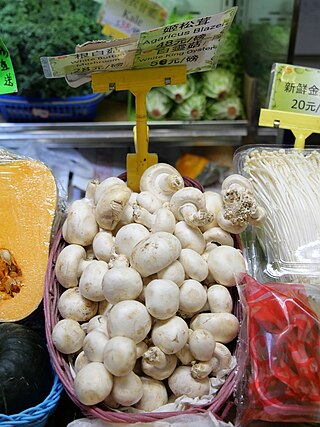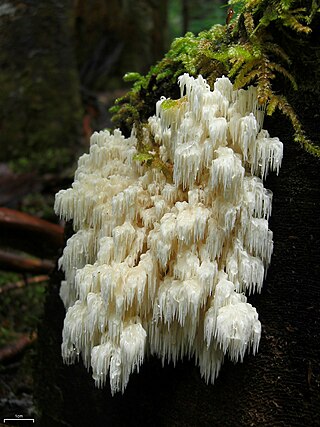
Edible mushrooms are the fleshy and edible fruit bodies of several species of macrofungi. They can appear either below ground (hypogeous) or above ground (epigeous) where they may be picked by hand. Edibility may be defined by criteria that include absence of poisonous effects on humans and desirable taste and aroma. Edible mushrooms are consumed for their nutritional and culinary value. Mushrooms, especially dried shiitake, are sources of umami flavor.

Hericium erinaceus is an edible mushroom belonging to the tooth fungus group. Native to North America, Europe, and Asia, it can be identified by its long spines, occurrence on hardwoods, and tendency to grow a single clump of dangling spines. The fruit bodies can be harvested for culinary use.

Orson Knapp Miller Jr. was an American mycologist. He published numerous papers in mycology and was responsible for the naming of many taxa, as well as being one of the authors erecting the genus Chroogomphus. He described Omphalotus olivascens, several species of Amanita, and the ghoul fungus Hebeloma aminophilum.

The Hericiaceae are a family of fungi in the order Russulales. The best known genus is Hericium, species of which are valued for their medicinal properties in Oriental medicine. Taxa are mainly known from north temperate regions, and are saprobic on rotting wood. Phylogenetic analysis suggests that Hericiaceae belongs to the russuloid clade of homobasidiomycetes, and morphological and molecular evidence links it with the families Auriscalpiaceae, Bondarzewiaceae and Echinodontiaceae. Originally proposed in 1961 by Taisiya Lvovna Nikolayeva as a subfamily of Hydnaceae, Hericiaceae was formally published as a family by Marinus Anton Donk in 1964.

Hericium is a genus of edible mushrooms in the family Hericiaceae. Species in this genus are white and fleshy and grow on dead or dying wood; fruiting bodies resemble a mass of fragile icicle-like spines that are suspended from either a branched supporting framework or from a tough, unbranched cushion of tissue. This distinctive structure has earned Hericium species a variety of common names—monkey's head, lion's mane, and bear's head are examples. Taxonomically, this genus was previously placed within the order Aphyllophorales, but recent molecular studies now place it in the Russulales.

Hericium abietis, commonly known as the bear's head or the western coral hedgehog, is an edible mushroom in the tooth fungus group. It grows on conifer stumps or logs in North America, producing a cream white fruit body up to 10–75 cm (4–30 in) tall and wide. It fruits from after the start of the fall rains to mid-season.
Simaria Assembly constituency is an assembly constituency in the Indian state of Jharkhand. The seat was created ahead of the 1977 Bihar Legislative Assembly election, being carved out of the Hazaribagh seat. Simaria is located in the Chatra Lok Sabha constituency.

Mahabali Singh Kushwaha(born 20 April 1955) is an Indian politician belonging to Bhabua, Kaimur district, Bihar. He was a member of the Indian Parliament, representing Karakat.
Clavulina wisoli is a species of coral fungus in the family Clavulinaceae. Officially described in 2003, it is found in Africa.

Hericium americanum, commonly known as the bear's head tooth fungus, is an edible mushroom in the tooth fungus group. It was described as new to science in 1984 by Canadian mycologist James Herbert Ginns.
Boletus recapitulatus is a species of bolete fungus found in Sikkim in northeastern India.
Upendra Singh Rawat is an Indian politician and is a member of the Bharatiya Janata Party. In 2019 General election he was the candidate from Barabanki constituency of Uttar Pradesh and he won the election with 535594 votes against the Samajwadi Party candidate Ram Sagar Rawat

Shyamamani Devi is a Odissi classical music vocalist composer. A disciple of Gurus Singhari Shyamsundar Kar and Balakrushna Dash, she is known for her popular renditions of classical Odissi music, such as Odissi, Chhanda, Champu, etc. authored by medieval Odia musician-poets such as Upendra Bhanja, Kabisurjya Baladeba Ratha, Banamali Dasa, Gopalakrusna and others. She is also known for her renditions of light music such as traditional Odia folk music and adhunika songs. In 2022, she was awarded the Padma Shri for he contributions to Odissi music.

Hericium novae-zealandiae, also known as pekepeke-kiore is a species of edible saprobic fungus endemic to New Zealand.

Hericium clathroides is a species of an edible fungus in the Hericiaceae family.

Hericium flagellum is a species of fungus in the family Hericiaceae native to Europe, first described by Giovanni Antonio Scopoli, and given its current name by Christiaan Hendrik Persoon in 1797. It was confirmed—using sexual incompatibility studies—to be a distinct species from H. coralloides in 1983. Found in montane areas, typically on newly fallen trunks and stumps of Fir. Spores are 5–6.5 by 4.5–5.5 µm.
Hericium yumthangense is a species of fungus in the family Hericiaceae native to Sikkim in India, first described by K. Das, Stalpers & Stielow in 2013 based on specimens from Yumthang. It can be distinguished from other Hericium growing in India by small rooting base, intricate three tier branching system, 8-13mm long spines.
Hericium bembedjaense is a species of fungus in the family Hericiaceae native to Cameroon, first described by Blaise Jumbam and Mary Catherine Aime in 2019, based on specimens from Dja Biosphere Reserve. It is found growing on Gilbertiodendron dewevrei and can be differentiated from other H. coralloides complex species by substrate and geographical range. It is the only Hericium species that has pleurocystidia.
Hericium bharengense is a species of fungus in the family Hericiaceae native to Sikkim in India, first described by K. Das, JA Stalpers & Ursula Ebelhardt in 2011. It can be distinguished from related species by "intricate" branching pattern of hymenophores, moderately long spines, size and ornamentation pattern of fruit bodies.
Hericium fimbrillatum is a species of fungus in the family Hericiaceae native to East Asia, given its current name by Ryo Sugawara, Nitaro Maekawa, Kozue Sotome, Akira Nakagiri, Naoki Endo in 2022, who transferred it from the Hydnum genus.










